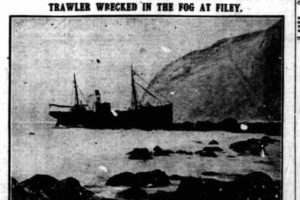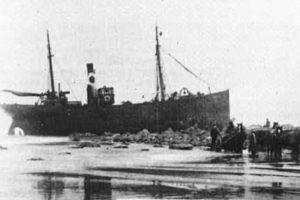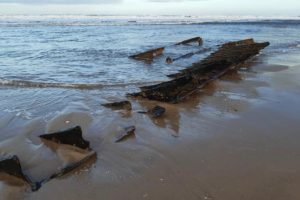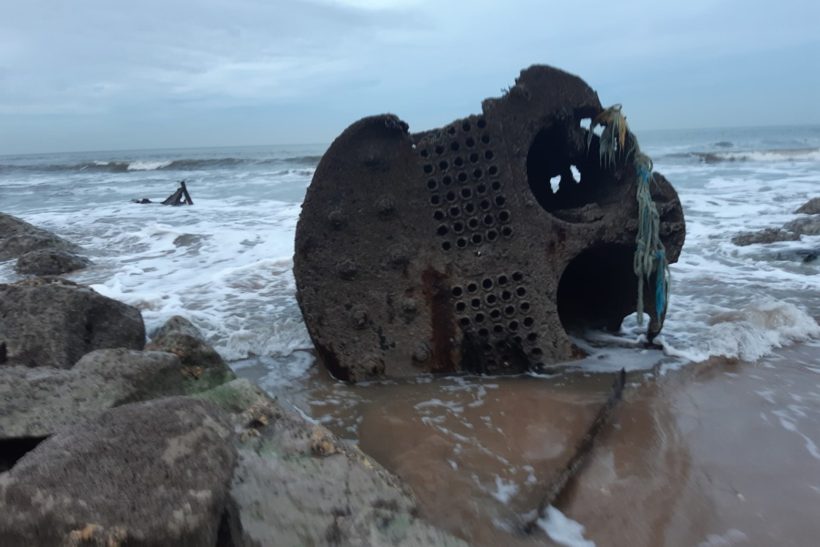110 years ago this month, a Hull trawler perished when she ran aground after crewmen mistook deadly white cliffs for snow. Brian W Lavery tells of the Diamond, the skipper who saved every soul aboard – and what became of them
Dawn had yet to break as the Diamond forged her way through a gale off Flamborough, heading home with a hold full of fish.
On deck, an engineer taking a breath of air amid the storm called down to the cabin: “Come and see the beautiful snow shower!”
It was seconds later that the ship’s cook below was shouting: “It’s not snow! It’s land!”
The ‘beautiful snow shower’ was Speeton Cliffs, which only weeks earlier had claimed the Hull trawler Lark when she was run aground.
Diamond’s bosun George Wood, who was on watch, had also thought he had seen snow, but soon noticed the breakers, and ordered the deckhand on the helm to turn hard to starboard.
The skipper was soon on deck too and ordered hard astern – but it was too late. It took just 10 minutes for the laden trawler to crash into the rocks.
Below deck, the engines crunched to a halt. Chief engineer John Ethell saw a massive rush of water extinguish his ship’s boiler fires in an instant.
The trawler was bumping heavily off the rocks, trapped under the cliffs. What had been a great and potentially very profitable trip had ended with the vessel smashed on the rocky shore.
The Diamond had sailed from Hull on 19 December, 1911, and after fishing near the East Fladden grounds about 300 miles NNE of Spurn Point into the first week of the new year, decided to head home.
At around 2am on 8 January, 1912, 41-year-old skipper Thomas Davies, happy with his full hold, was aware he was racing raging winter weather, and set a SSW course for the homeward voyage.
Throughout the return trip, the trawler ran the SSE gales, until the crew made the catastrophic misjudgement of mistaking cliffs for snow.
When bosun George Wood came on watch at six in the morning that 9 January, the Diamond had still been going full speed on her original course.
With the vessel aground, the crew tried to launch their small boat, but a boiling sea was running as the trawler bumped heavily against the rocks.
By the time the Flamborough lifeboat crew and the local rocket lifesaving company arrived on the scene, the trawler crew had been rescued and brought ashore by two Flamborough cobles, skippered by local men Sam Chadwick and John William Pockley (known locally as Jack Hart).

A picture of the wreck from the Hull News in January 1912.
Both men had great reputations, but Chadwick’s rescue skills were renowned all along the fisheries of the east coast.
North Sea inshore fishermen along that coast had long played an important role in helping merchant vessels that got into trouble.
Flamborough coble skipper Sam Chadwick had uncanny skills in helping stranded vessels.
The distinguished Hull-based maritime historian Dr Robb Robinson, who is researching stories of the North Sea for a new book, including the story of the Diamond, recounts how Chadwick reached legendary status among his peers.
Dr Robinson said: “When Sam ‘Bonny’ Chadwick died in 1919, it was said that he had negotiated and assisted the refloating of more vessels beached at Flamborough than any other fisherman, and was once presented with a gold watch in recognition of his services in helping refloat one particularly large steamer.”
Chadwick saved all hands from the Diamond, and arranged for the catch to be moved to Hull, but even he could not save the ship or release her from the rocks.
Dr Robinson added: “The Diamond had come ashore about a mile from where the steam trawler Lark had been stranded a month previously.
“A portion of the fish catch was removed the following day and forwarded to Hull for sale. There were some initial hopes that the vessel could be refloated, but despite the skills of Bonny and his colleagues, these proved illusory because of the extent of the damage.”

The wrecked Diamond at Speeton Cliffs in January 1912.
Saving the catch not only benefited the trawler bosses, the Kingston Steam Trawling Company Ltd, but also the men, who would have been depending on their share.
Soon after the Diamond’s men had been taken off, the Filey lifeboat crew, which had also been alerted, arrived at the scene, but on boarding they discovered that the stricken trawler was by then deserted.
The crewmen of the Diamond were billeted at the local Foord’s Hotel in Filey, before being returned to Hull.
On a lighter note, an engineer from the Diamond who was on leave at the time disaster struck got a visit from some drunken crewmates later, who shouted up to his window: “Hey Billy, she’s come for you, lad!”
In February 1912, a Board of Trade inquiry opened into the loss of the Diamond.
At first, it concentrated on the role of bosun George Wood, who had been on watch when the disastrous mistaking of cliffs for snow had happened. It seemed that his career was in jeopardy. But the mate, George Kelk, came to Wood’s rescue.
Kelk was missing when the inquiry opened, having been arrested for debt. But he was tracked down a few days later, and gave some devastating testimony against Skipper Davies.
Kelk told the court that at no time had he seen Thomas Davies on deck during any of the watches. It soon became clear that the main blame for the disaster was to be attached to the skipper.
The judge heading the inquiry was reported in the Hull News of 17 February, 1912 as saying: “That is a scandalous state of affairs.”
It is not known why the skipper was not present across any of the three watches before disaster struck. But the inquiry decided that his negligence had cost his employers a ship – and could, more importantly, have cost the men their lives.
But by today’s standards, Skipper Davies’ punishment seems ludicrous. He had his skipper’s certificate suspended for just three months – and the court also decided that he could carry on working as a mate in the meantime if he could find employment.
In theory, he should have been well cushioned, for a few weeks later he received more than £80 – about £1,800 in today’s money – in settlement of his share of an earlier salvage of a large ship called the Sair Port the previous year.
But Dr Robinson’s research on the Blaydes Maritime Centre University of Hull website shows that there was at least some poetic justice meted out to the errant skipper.
In June 1912, Davies was jailed by magistrates at Brixham Petty Sessions for arrears of maintenance due to his estranged wife.
Out of the salvage monies he had received, he had only sent her £5 10s, around £100 in today’s money – a fraction of what he got.
Davies claimed to the court that he had had bad luck, and said he was also having to pay an additional 2s 6d a week to his mother, as well as keeping another woman and child.
The bench was unimpressed by the skipper’s complex private life and list of excuses, and he was jailed for a month.
Dr Robinson has been joined in his maritime history website project by family research expert Peter Chapman, who helped to unearth the human stories behind the history of the Diamond.
He writes: “It turns out that Davies was living with Mary Louise Trickett (née Blackman), a 22-year-old widow by whom he seems to have had a son in 1911.
“Mary’s late husband, Chandos Jepson Trickett, who usually went by the name of James, had been mate on the Hull trawler Terrier when he was dragged overboard by the trawl warp and drowned whilst the vessel was fishing some 270 miles NE of Spurn in January 1908.
“One of the trawler’s deckhands, George William Brown of Westbourne Crescent, Edinburgh Street, was later presented with a bronze award for gallantry from the King for his attempts that day to save the stricken mate.
“What is particularly interesting from our point of view is that the skipper of the Terrier at the time was Thomas Davies. It was presumably some time afterwards that he had moved in with Mary.”
With the outbreak of the First World War, Davies became a skipper in the Royal Naval Reserve (Trawler Section), and was assigned to the trawler Elite – but by early January 1915 he had been discharged for misconduct. But as Peter Chapman explains, Davies was not an unusual case when it came to discipline.
“At the beginning of the war, large numbers of skippers and fishermen from all over the country had been rapidly drafted into naval service for minesweeping and anti-submarine duties.
“The cultural gulf between Dartmouth- and Osborne-trained naval officers and the working fishermen they suddenly had to command was enormous. Enforcing naval discipline amongst the fishing fraternity was fraught with problems and a number of fishermen, who seemingly proved particularly difficult to command, were dismissed in early 1915, and it seems likely that Davies was one of these.”

The remains of the Diamond, 110 years on.
Skipper Davies was not the only crewman from the Diamond’s last trip to find himself in Royal Navy service in the war. At least six members of the nine-man crew served.
John William Ethell, the chief engineer who watched the boiler fires suddenly extinguish, was already a member of the Royal Naval Reserve when he signed up for ‘short service’ in July 1914, about three weeks before Britain entered the war.
He was by then almost 42 years old. In spite of his age and the ‘short service’ deal, he ended up serving until 1920.
According to naval records, Ethell joined the Mine Clearance Service after the war. He was awarded a Distinguished Service Medal.
Edward Heron, the Diamond’s last cook, was at least 51 when he joined the Auxiliary Patrol in November 1915. He was sent to Queenstown, near Cork, to serve as cook on the requisitioned drifter Colleen, but he lasted no more than six months before he was invalided out.
The Diamond’s bosun, George Geoffrey Wood, who tried in vain to steer the ill-fated trawler from the rocks, joined the Auxiliary Patrol in February 1915 and served for the remainder of the conflict in the bitter coastal war against mines and U-boats.
Edward Tucker, a deckhand on his first trip on the Diamond in 1912, was 23 when he signed up in July 1915.
Records show he was posted as missing from 20 July, 1917 with the rest of the crew of the Admiralty trawler Robert Smith, which was later reported to have been sunk with gunfire by the German submarine U-44 in the Atlantic.
Edward Bowles, formerly third hand on the Diamond, also joined the Auxiliary Patrol in November 1916. He was still on trawlers during the early part of the Second World War, and lost his life aged 54 on the Grimsby trawler King Eric, which was torpedoed in September 1941. He is remembered on the Memorial to Fishermen and Merchant Seamen at Tower Hill in London.
The other coble skipper involved in rescuing the Diamond’s crew back in 1912 was also to be claimed by the sea. John William Pockley, aka Jack Hart, was a crew member of the Arrow, one of 10 Bridlington motor cobles caught out at sea in a sudden storm in November 1923.
Pockley’s body was later washed up on the sands at Sewerby, near Bridlington. He was 64 years old.
The story of the Diamond is both a disaster and a triumph. The fact that all men aboard were saved is remarkable of itself, given that the area was known a ‘graveyard’ for North Sea trawlers heading back to Hull.
Fishermen are superstitious. And their luck was definitely in that fateful day, when the remarkable skipper Sam ‘Bonny’ Chadwick came to their aid before the lifeboat could.
Countless lives were touched across the decades by this one incident, the historical and human interest elements of which combine in the remarkable research being undertaken at the Hull-based Blaydes Maritime Centre – and which proves that history is not only what we read, but what we all live through.
Dr Robb Robinson and Peter Chapman’s research and that of their colleagues at the Blaydes Maritime Centre, including the story of the Diamond and its aftermath, can be found at: bit. ly/3GkPht2
Photos and images courtesy of Dr Robb Robinson of the Blaydes Maritime Centre at the University of Hull, and the Filey Bay Maritime Heritage website.






